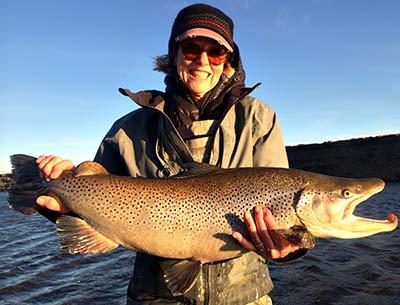The Ferrins On The Fly, Globally

Ken Ferrin first fly-fished at the age of 19 at Flathead Lake in Montana, where he was the waterfront director at a boys camp.
A long hiatus followed, until four years ago, at the age of 78, he suggested to his wife and tennis and cycling partner, Patti, with whom he’s biked all over the world, that they forgo heli-skiing, which they’d done for 20 years, in Canada, in favor of fly-fishing.
That was many fishing trips ago, to beautiful, remote places in Chile, the Gaspe Peninsula in Quebec, the Aleutian Islands in Alaska, Belize, and Patagonia, on the Chilean and Argentine sides of the Andes.
“We love remote places,” Ken Ferrin said.
“East Hampton used to be — when we first came here, in the early ’70s,” his wife observed after their guest had said something about “the Hamptons.”
“Our first fly-fishing trip,” he said, “was on a boat named the Nomad, in Chile, a big yacht that had two helicopters on it. This man, a very wealthy guy, loved to heli-ski and fly-fish. He’d fly people up to lakes in Chile that nobody else could get to.”
“Actually, it was more of a spa, more of a party boat than a fishing boat,” said Patti Ferrin, who even in this weather rides her mountain bike between their house off Lily Pond Lane and the East Hampton Indoor Tennis Club.
“The real fishermen said that this wasn’t real fishing . . . still, they were very nice fellows. Anyway, Patti liked the fishing,” he said with a smile, “and the partying.”
Yes, fly-fishing was a very technical sport, they agreed, and it was a good thing too, they added, that they had both come to it from tennis. “It’s basically the same motion as a serve,” he said. “The rod arcs back and then forward out over the water, shooting the line out. You’re not casting the fly — you’re casting the line.”
“They’re all different weights — the rods and the lines,” she said.
They went for trout — big trout, up to 20 and 30 pounds in some cases, browns and rainbows — on their most recent trip, to Tierra del Fuego.
The routine there differed a bit from what they’re used to. They’d fish from 8 to 12:30 p.m., go back to the lodge for a big lunch, “and then,” he said, “you take a nap and don’t go back until 6. You fish from 6 to 10, until it gets dark — you can catch fish in the dark. And then you go back to the lodge and shower and have dinner at midnight. You’re in bed by 1, and up at 6. You’re so burned out by the end of a week that you could sleep on a rock.”
Since they release what they catch, and often don’t catch much of anything, some friends wonder what draws them to the sport, but both agree, as he said, that “the tug is the drug.” That there’s a thrill when a fish is lured by a tiny, nicely tied fly cast ever so gently and invitingly, usually a few feet in front of it.
“You can’t disturb the water too much,” he said. “It can’t go plunk.”
“And if it takes the hook — the hooks are very small — can you land it?” she said.
“Half the time they jump off,” he said. “We practice out here,” he said, waving toward the snow-covered lawn, just up a ways from the beach, where, in season, they catch bluefish and striped bass. “If you don’t practice, you don’t get better,” he said, as she nodded. “In the course of a week, we make 600 to 700 casts — thousands a year.”
“We’ve come a long way,” he said. “I remember showing the poly bag of equipment I’d brought to a fisherman on the Nomad and saying, ‘I think I have all the things, I just don’t know how to put them together.’ He gave me a dubious look and told me to go see the guide.”
She brought out a small sampling of the lures they have, this particular group including green ones resembling tiny crabs on leaves, said to be favored by the very elusive silvery permit fish. “We’re going to Mexico, to the Yucatan, in April to fish for them. You hope a permit will take your crab rather than a real one.”
“The pink ones,” she said, as their interviewer continued to peer at the box, “are for bonefish, for bonefish and tarpon. We went bonefishing in the Bahamas in November. He caught one, I caught none. It was really bad weather, rainy and windy. Then we found out you don’t go down there in hurricane season.”
So, where else was there to go?
“Oh, there’s Russia — there’s very famous Atlantic salmon fishing there,” he began. “There are really big fish in Kamchatka, that peninsula near Japan that the Russians and Japanese fought a war over in 1905, but I don’t think we’ll go there.”
“You fly direct from Anchorage,” she said. “There’s one flight a week.”
“And Christmas Island, in the middle of the Pacific, where there are bonefish.”
“There’s one flight a week, out of Honolulu,” she said. “A six-hour flight.”
“We haven’t told you about the Seychelles, off India,” he said. “But we’re not going there.”
“He’s said, ‘We’re not going there’ a lot of times,” she said, with a laugh.
